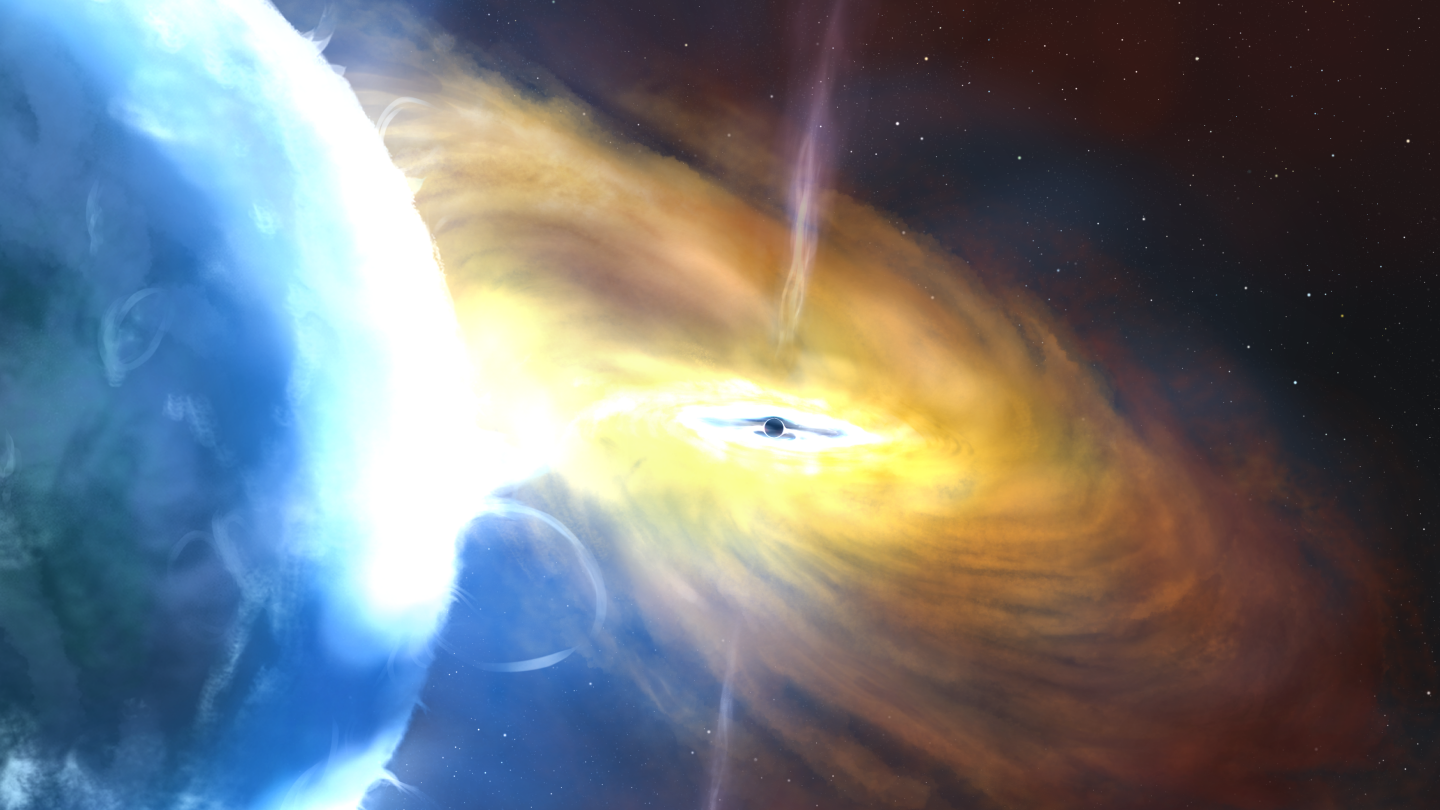The researchers observed the X-ray radiation from the matter around a black hole. According to the researchers the shape and orientation of the X-ray glow support the theory, that the X-rays come from the disc-shaped material flowing into the black hole which is perpendicular to previously imaged relativistic outflows of matter called jets. These findings give a better understanding about the inner workings of black holes and how they consume mass.
It is well known that massive stars, which weigh over 25 Suns, end their lives in a highly compact remnant, the black hole.
If such a star has a nearby companion, at some stage of the binary evolution the black hole will consume matter from that. As the matter is pulled by the strong gravity of the black hole, it is heated to millions of degrees and we are able to observe the bright X-ray glow from these systems, which are called X-ray binaries.
The configuration of this matter, however, has been a matter of debate, and these sources are too distant: distinguishing them in the sky is like trying to discern a hair on the surface of the Moon. No current technologies are capable of doing an image of such a system.
"It is not even clear whether we see the last sights of matter before it goes beyond the event horizon – the imaginary surface, beyond which no information can reach the distant observer – or, instead, if it is a cry of joy of a small fraction of material which escapes the system, " says Juri Poutanen, Professor of Astronomy at the University of Turku. "There have been suggestions that the X-ray glow of matter we see forms a highly compact sphere. Other alternatives included an elongate structure, either as a slab entering the black hole or in a shape of the cone, pointing away from the black hole."
Recently, astrophysicists found a way to get insights into the configuration of the X-ray emitting gas. They used the special property of light called polarization. The light can be thought of as a set of coming waves. But unlike the waves in the ocean, which can oscillate only in the vertical direction, up and down, the light waves may have these oscillations in any direction. Polarization is the appearance of one preferential direction of these oscillations.
X-ray polarization can be produced in scattering, when the photons bounce from one particle to another. In this case, its orientation is related to the symmetry axis of the system. Detecting this orientation from the ultrashort X-ray wavelengths is a highly challenging task; this became feasible with the launch of the Imaging X-Ray Polarimetry Explorer (IXPE) space mission, an international collaboration between NASA and the Italian Space Agency (ASI).
The first massive stellar remnant studied with this mission was the prototypical black hole X-ray binary Cygnus X-1, which is also the first X-ray source discovered in Cygnus constellation during a rocket flight in 1964, and the first source that was widely accepted to be a black hole.
Polarimetric measurements from Cyg X-1, reported on November 3 in the journal Science, reveal that the X-ray emitting gas extends perpendicular to a two-sided, pencil-shaped plasma outflow, or jet, imaged in earlier radio observations.
"The new data rule out models in which the X-ray emitting gas forms a compact substance or a cone along the jet axis, instead lending strong support to the hypothesis that the X-ray glow comes from the inflow of matter," explains Alexandra Veledina, one of the leading authors of the publication. "A better understanding of the plasma geometry can reveal much about the inner workings of black holes and how they consume mass."
Furthermore, IXPE observations reveal that the inflow is seen more edge-on than previously thought. This may indicate the misalignment between the black hole spinning axis and the axis of the orbit in which the black hole is rotating around the massive companion.
"In order to verify this assumption, we performed an observational campaign with the high-precision optical polarimeter DIPol-2, which can say about the direction of the orbital axis on the plane of the sky," says Andrei Berdyugin, senior researcher at the University of Turku and a co-developer of high-precision optical polarimetric instruments1.
"However, unlike in another black hole binary system2, where we have been able to identify a large misalignment seen in the plane of the sky, the binary orbit in Cyg X-1 is very well aligned with the black hole spin axis," he adds.
"Exciting finding opens new prospects to study the curved spacetime and laws of gravity in unprecedented detail. We have already found a lot of surprises in a wide range of sources, from the ultra-dense stellar remnants called neutron stars3 to the supermassive black holes in the centers of galaxies," concludes Poutanen. "We are thrilled to be part of this wave of new scientific discoveries."
The paper ”Polarized x-rays constrain the disk-jet geometry in the black hole x-ray binary Cygnus X-1” is published in the Science journal.
The authors from the University of Turku are Alexandra Veledina, Vladislav Loktev, Juri Poutanen, Andrei Berdyugin, Vadim Kravtsov ja Sergey Tsygankov from Tuorla observatory.






